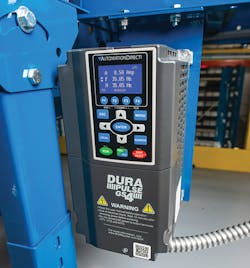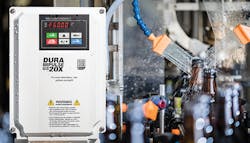Advanced variable frequency drives are working in more applications
In this article:
- Early AC speed control
- The modern VFD
- Advanced automation
- Advanced control modes
- AC permanent magnet (PM) motors
- VFDs drive safety
- Connected VFDs
- VFD systems as a preferred solution
In the world of alternating current (AC) motors and their associated shaft-turning applications across all industries, no components have made a greater impact than the AC variable frequency drive (VFD). The ability of VFDs to precisely control motor speed and torque, reduce overall energy consumption, and minimize equipment wear have opened the door to many applications that formerly required more complex and expensive electro-mechanical solutions.
VFDs themselves have undergone tremendous technology advancements, accelerating their use beyond basic functionality. They have gained enough capability to act as a small standalone control system, or to play an integral role as part of a larger industrial internet of things (IIoT) data gathering initiative.
Some of these advancements have been coming in phases for a while, but in the past decade VFDs have evolved from simple, stand-alone accelerate/decelerate motor speed controllers to become advanced and efficient devices with control and safety networked together and able to perform as a complete small system controller. This article will survey the more advanced features commonly available for AC VFDs, and how an industrial plant or facility can best put them to use.
Early AC speed control
Nikola Tesla was granted a patent for the first three phase AC motor in 1888. However, Thomas Edison’s direct current (DC) motors remained king in manufacturing for the first half of the twentieth century due to the difficulties in regulating the speed of the AC motors. Even though Tesla knew AC was much more reliable and efficient than DC, the lack of practical speed control kept AC motors on the sidelines.
Speed control of DC motors was relatively straightforward, but originally AC motors required expensive and complex mechanical systems for speed control. Another factor for industrial use was that DC motors have far greater torque than AC motors when starting from zero or low speed.
The development of power semiconductors made it possible to create solid-state AC VFDs in the 1960s, although originally, they were only viable for very large motors used in heavy industry. It was not until the 1980s that the VFD entered the mainstream of industrial controls.
One of the key contributing factors in this sudden evolution of VFDs was the advancement in semiconductor technology. In the 1990s and early 2000s, chips became smaller, more reliable, and less expensive, largely due to the developments in cell phone technology, which migrated into industrial hardened components and products.
The modern VFD
Today’s VFDs are available in compact form factors and can reliably operate motors of all sizes, across a span that may range from nearly 0Hz all the way up to 400Hz. This is quite a range compared to the nominal 60Hz fixed speed. Not only that, but precise speed control of 0.01Hz resolution with an accuracy of 1% of maximum output frequency is possible. Similarly, torque control can apply up to 200% rated torque at as low a speed as 0.5Hz (see Figure 1).
These horsepower and torque capabilities allowed VFDs and AC motors to be used in many more applications. However, the original VFDs were intended simply to drive the motor, and not to replace more advanced control functions.
As technology continued to advance, drives become more capable. Basic analog devices with elementary ramp algorithms and simple PID loop control functions have transitioned into fully digital controllers capable of advanced motor control functions. Fundamental control devices have evolved to include built-in programmable logic control (PLC) functionality. Many VFDs gained extensive data communication abilities.
Advanced VFD features, particularly those providing integrated PLC functionality, are still subject to some limitations, such as the number of connected input/outputs (I/O) and the program memory size. However, for many applications like tank farms, lift stations, and diverter gates, there is a need for this type of simple local control.
Advanced automation
Motors driven by AC VFDs provide sufficient accuracy for many applications, and on-board PLC logic has enabled VFDs to robustly control many local operations (see Figure 2). However, users have always recognized the gap between historically analog VFDs, and high precision (and correspondingly high-priced) servo drives.
There is a definite divide between VFD-driven motors and servo motors when it comes to ultimate precision and torque control, but there are two key factors that have greyed the lines of VFD versus servo. In many cases VFD solutions can now work in applications formerly reserved for servos, but at a fraction of the cost.
Advanced control modes
The most common and simple VFD control algorithm is Volts per Hertz (V/Hz or V/f). Most modern VFDs will still default to this control mode because it requires the fewest steps to get the system up and running, and it’s still appropriate for more than 80% of the motor control applications. But those other 20%? This is where these more advanced control methods come into play.
How to protect VFD motor bearings using nanocrystalline inductive absorbers
What you need to know about AC motors and VFDs
The basics of variable-frequency drive installation
In many cases these algorithms require the VFD to perform an auto-tuning procedure while connected to the motor. This allows it to set some internal parameters to provide more precise control. Technologies with names like sensorless vector, field-oriented control, and full closed loop flux vector are specific modes using implied or actual encoder feedback, enabling the VFD to provide more precise control. Certainly, these capabilities promote VFDs into the grey area of almost-servo-like functionality. For the right applications, applying these advanced VFD control modes can save the user hundreds or thousands of dollars when compared to a comparable servo system.
AC permanent magnet (PM) motors
Traditionally, VFDs were only compatible with 3-phase AC induction motors (IM). However, now that VFDs have more advanced control modes and more intelligence, support for PM motors is becoming more commonplace.
The advantages of these motors when compared to a standard IM motor include smaller sizes and greater efficiency. PM motor leads can be shorted when powered down so that the motor holds position like a servo, and they also provide maximum torque at 0RPM and good dynamic performance. These features make them very attractive, especially for machine builders where space and speed control precision are a concern, or in applications where higher upfront cost is more than balanced by energy savings.
VFDs drive safety
Looking beyond control functionality, new safety-related features have become commonplace in modern VFDs. Here are several examples:
- Safe torque off (STO)
- Fire mode
- Safe stop modes
- Safe brake control
- Safely limited speed
- Safe direction
- Safely limited acceleration
STO is built-in to the latest VFDs and is designed to meet applicable standards like EN ISO 13849-1 PLd and EN 61508 SIL2 (EN 60204-1, stop category 0). When safety devices are wired to the STO inputs of a VFD, the drive circuitry ensures the output can only be energized if a safe condition is detected. This is the preferred way to safety interlock a VFD, compared with older methods that required external contactors and wiring to interrupt the upstream and/or downstream circuits. Other “safe” functions listed above can also assist in designing an application to increase safety.
Fire mode allows a VFD to ignore all internal faults and remain enabled if a special input indicates there is a fire condition. The VFD will basically run until it destructs, which at first may seem counterintuitive. However, this is a common need when controlling critical life-safety equipment like an exhaust fan or stairwell pressurization fan, so people escaping from a fire will have fresh air. As a point of interest in most cases, once a VFD is placed into fire mode it may be permanently damaged and will not be covered by the manufacturer’s warranty.
Connected VFDs
In addition to control and safety, the networking and communications aspects of VFDs is another area that has advanced rapidly. Original VFDs relied on simple discrete and analog hardwired I/O signals. This progressed to industrial digital fieldbus connectivity, enabling the networking of many VFDs on a single network (see Figure 3).
In recent years, Ethernet communication using various industrial protocols like Modbus TCP and EtherNet/IP has become the de facto standard for networking multiple VFDs, and in many cases is now more common than hardwired I/O. More and more, VFDs are receiving their command signals from and providing status information to associated PLCs or other controllers via Ethernet. Of course, Ethernet-connected VFDs can also provide extensive operating data and statistical information, and accept configuration information from higher-level components, such as a PLC.
VFD systems as a preferred solution
Outside of the previously described functions, the primary benefit of installing a VFD in most applications remains significantly increased energy efficiency and equipment life. Converting a motor from on/off control using an across-the-line starter to VFD control can reduce energy consumption by as much as 50%.
This is possible for several reasons. Operating the motor at less than 100%, when this is suitable for the load, offers tremendous energy savings. Smooth motor acceleration greatly reduces inrush current, and reduces peak values on which utilities may base their billing rates. Some VFDs even have a “sleep mode,” which de-energizes the motor during PID control to match process requirements.
For example, when replacing a standard efficiency on/off controlled 20hp motor with a premium-efficiency motor operated by a VFD in an area with an electricity price of 10 cents/kWh, users will often discover:
- Cost savings of up to $1,200/year, resulting from motor efficiency and from operating the motor about 20% lower than full speed, which is still optimal for the load.
- Quick return on investment as energy savings may pay for the upgrade in less than two years.
- Optimized machine and equipment operation, producing higher quality product with less waste and equipment wear.
The transformation of AC VFDs has been neither slight nor overnight. Instead, a steady evolution has progressed this component from a basic power device for simple motor control into a comprehensive platform for safely directing enhanced motor functionality and delivering advanced IIoT information and diagnostics.
Designers should familiarize themselves with all the latest possibilities as these make modern VFDs essential for many aspects of safety, control panel design, local industrial control and integration with plantwide automation systems.
This story originally appeared in the June 2021 issue of Plant Services. Subscribe to Plant Services here.
Jeff Payne is a product manager for the Drives & Motors Group at AutomationDirect. Before joining the company 20 years ago, he managed, designed, programmed, installed, maintained and repaired a wide variety of highly automated equipment. He has been working in the field industrial automation for nearly 28 years and earned a degree in Industrial Systems Technology and Industrial Automation from Lanier Technical College.



